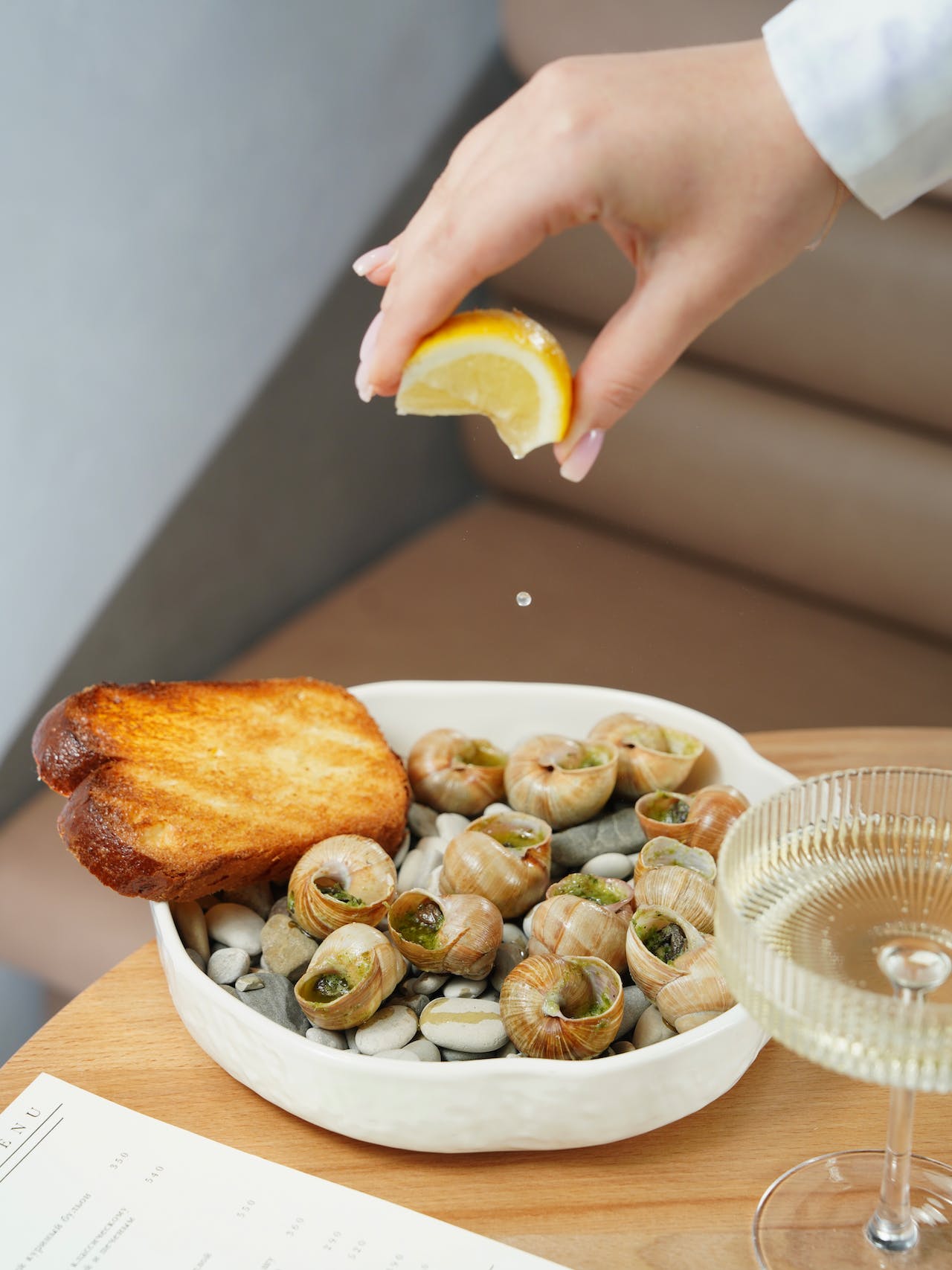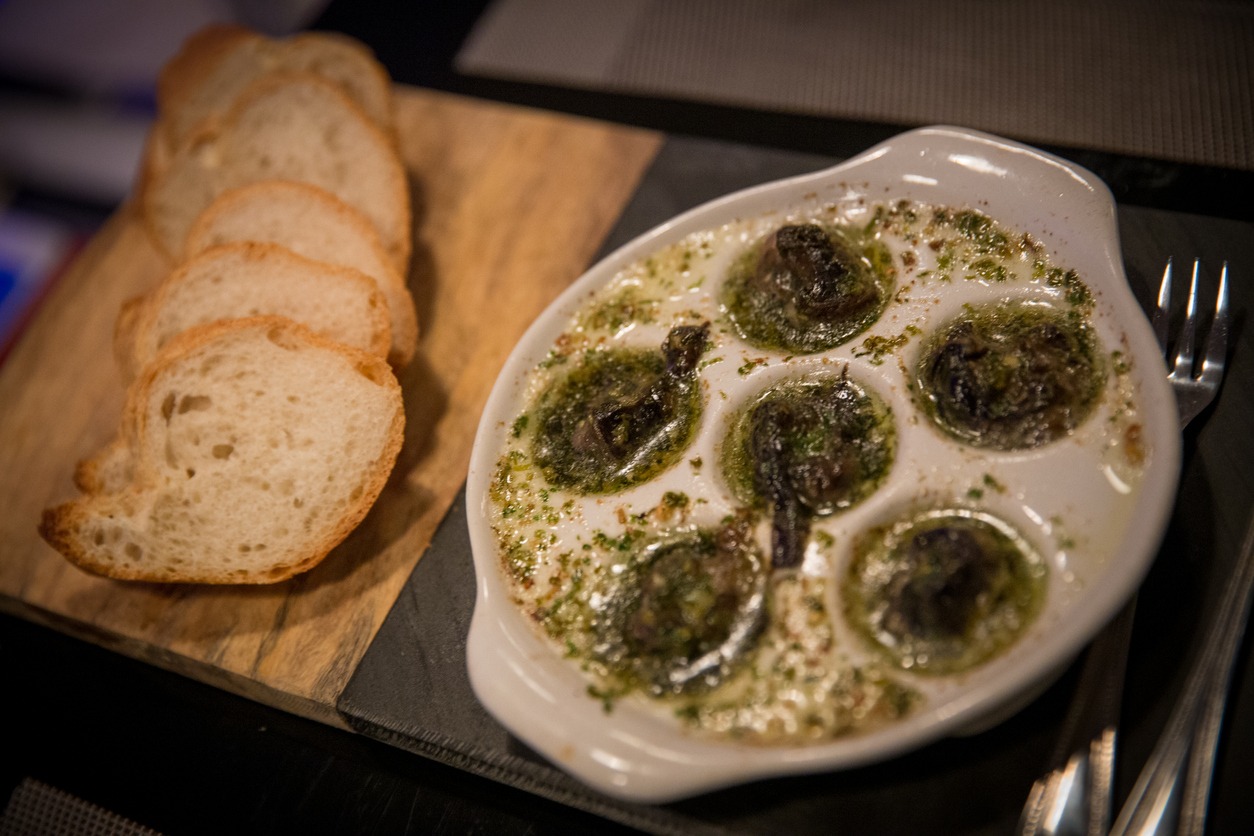Ah, escargot! The mere mention of this delicacy conjures up images of chic Parisian bistros, clinking glasses of Chardonnay, and the seductive aroma of garlic butter. As a self-proclaimed foodie, my journey through the world of gourmet cuisine would be incomplete without delving into the luxurious realm of escargot. Let’s embark on a culinary adventure, exploring the history, preparation, and sheer joy of savoring this exquisite dish.
A Snail’s Tale: The History of Escargot
The history of escargot, a dish that has tantalized palates and intrigued gastronomes for centuries, is as rich and complex as its flavor. To trace the journey of this humble mollusk to the echelons of gourmet cuisine is to embark on a fascinating voyage through time and culture.
The story of escargot begins in prehistoric times, evidenced by archaeological findings of snail shells in ancient sites, suggesting that humans have been consuming these creatures for thousands of years. However, it was the Romans who first elevated the snail from a mere source of sustenance to a delicacy. Roman gourmands not only savored snails but also perfected the art of snail farming, or ‘Heliciculture’, creating the first snail gardens. They fed the snails special diets to cleanse their systems, fattened them up, and even developed recipes that are echoed in today’s culinary practices.
As the Roman Empire expanded, so did the love for escargot. With the fall of the Roman Empire, the tradition of eating snails spread across Europe. Each region adapted the dish to its local flavors and ingredients, but it was in France where escargot found its true culinary home. The French transformed it into a symbol of fine dining, an icon of the nation’s culinary identity. It’s in the Burgundy region of France where the escargot we know today truly came into its own, with the Burgundy snail, ‘Helix pomatia’, becoming the most coveted variety.
The Renaissance period saw a resurgence in the popularity of escargot. It became a dish associated with the aristocracy, a luxury that graced the tables of the wealthy and powerful. This association with high society set the stage for escargot’s enduring status as a gourmet delicacy. By the 19th century, escargot had become an integral part of French cuisine, immortalized in cookbooks and served in the burgeoning restaurant scene of Paris.
However, the journey of escargot is not just a European tale. With the advent of global exploration and trade, the practice of eating snails spread to other parts of the world. In many African and Asian cultures, snails were incorporated into traditional dishes, each adding their unique twist to the preparation.
The 20th century saw escargot firmly entrenched as a staple in French cuisine. Its popularity soared, and it became a symbol of French culinary excellence, served in bistros and fine dining establishments alike. The dish became so popular that the demand for the Burgundy snail led to its near depletion in the wild, prompting the need for more sustainable farming practices.
Today, escargot is not just a dish but a piece of culinary history, a testament to the journey of food through time and culture. It’s a dish that has evolved but has always retained its core identity – a luxurious, flavorful experience that speaks of the earth and tradition. In a bowl of escargot lies the story of human civilization, from ancient foragers to Roman gourmands, from French aristocrats to modern-day epicures. This snail’s tale is a continuous thread in the rich tapestry of our global culinary heritage.
Snails in the Kitchen: Types and Preparation
The journey from garden to plate is a meticulous one. Not all snails are destined for the dining table; the most commonly savored varieties include the Burgundy snail (Helix pomatia), the garden snail (Helix aspersa), and the Roman snail (Helix lucorum).
Preparing escargot is an art in itself. It begins with purging the snails of any impurities, a process that involves feeding them a special diet for several days. The snails are then cooked, typically boiled in a broth of aromatic herbs, creating a canvas of flavors. They are then removed from their shells, prepared with a rich, garlicky butter sauce, and returned to their shells for serving – a full circle of culinary elegance.
The pièce de résistance of escargot is undoubtedly the butter. A concoction of unsalted butter, copious amounts of garlic, shallots, parsley, and a splash of brandy or white wine, it’s what elevates the dish from mere snails to a culinary marvel. The butter not only complements the earthy flavor of the snails but also serves as a delectable dip for crusty French baguette, an integral part of the escargot experience.
The Escargot Experience
The texture if escargot may not be what you would expect – tender, not rubbery, with a taste reminiscent of mushrooms, soaked in the rich, herbaceous garlic butter.
Pairing escargot with the right wine is crucial. A crisp, dry white wine like Chablis or Sauvignon Blanc complements the richness of the dish without overpowering it. The wine’s acidity cuts through the butter, creating a balance that dances on the palate.
Escargot Around the World: A Global Delight
While escargot is quintessentially French, its appeal is global. In Portugal, ‘Caracóis’ is a popular summer snack, simmered in a broth of garlic and oregano. In African cuisine, snails are often served in spicy sauces, a testament to the dish’s versatility across different culinary landscapes.
This global journey of escargot is a testament to its adaptability and the universal appeal of its unique flavor profile. From the streets of Lisbon to the fine dining establishments of Paris, escargot transcends boundaries, unifying food enthusiasts in their appreciation for this exquisite dish.
Escargot at Home: Demystifying the Preparation
For the daring home chef, preparing escargot is a rewarding endeavor. While fresh snails can be a challenge to source, canned snails are a practical alternative, offering a shortcut without compromising on flavor.
The key lies in the butter sauce. It’s where your culinary creativity can shine. Experiment with different herbs, adjust the garlic to your liking, and perhaps add a dash of lemon zest for a citrusy twist. Remember, the bread for soaking up the sauce is just as important – a fresh, crusty baguette is non-negotiable.
Sustainability and Ethics: A Modern Foodie’s Concern
In today’s world, where sustainability and ethical eating are increasingly paramount, it’s essential to consider these aspects when indulging in escargot. Sustainable farming practices and ethical sourcing are crucial in ensuring that our culinary pleasures do not come at an environmental cost. Opt for escargot from sources that prioritize these values, contributing to a more sustainable and responsible culinary culture.
Escargot in Fine Dining: A Chef’s Canvas
In the hallowed halls of fine dining, escargot is not merely a dish; it’s a chef’s canvas, a medium through which culinary artists express creativity, tradition, and innovation. The humble snail, when presented on the fine dining stage, undergoes a transformation that is nothing short of gastronomic alchemy.
Imagine a dish where escargot is the star, but the supporting elements elevate it to a realm of uncharted flavors and textures. Chefs in top-tier restaurants experiment with ingredients and techniques that transform the traditional escargot into avant-garde creations. For instance, envision escargot served with a delicate foam of garlic and parsley, embodying the classic flavors in a light, ethereal form. Or picture an escargot terrine, layered with herb-infused butter, a mosaic of garden vegetables, and edible flowers, offering a symphony of flavors, colors, and textures in every bite.
The versatility of escargot allows chefs to explore a range of culinary traditions and techniques. In a nod to fusion cuisine, you might find escargot paired with Asian flavors – imagine snails drenched in a ginger-soy glaze, served with a side of lemongrass-infused jasmine rice, marrying French tradition with Eastern zest. Or, in a more Mediterranean twist, escargot can be baked in a tomato-based sauce, rich with olives and capers, a homage to the rustic, hearty flavors of the region.
Fine dining chefs also love to play with presentation, and escargot offers a unique opportunity in this regard. Instead of the traditional snail shells or ramekins, creative plating techniques come into play. Picture a sleek, modern dish where escargot is elegantly arrayed on a piece of natural slate, each snail resting on a bed of microgreens, drizzled with a saffron-infused butter sauce, the vibrant yellow streaking across the dark stone like a brushstroke on a painter’s canvas.
Furthermore, the fine dining experience is as much about the theatrics as it is about the cuisine. Some chefs have taken to presenting escargot in a manner that engages the diners directly in the final steps of preparation. A tableside finish, perhaps, where the waiter flambeés the snails in a pan of brandy or Pernod, igniting the alcohol with a dramatic flare and infusing the dish with a smoky, complex aroma. This interactive element not only adds a touch of drama to the dining experience but also heightens the anticipation and engagement of the diners with their meal.
In fine dining, escargot is an enduring testament to the chef’s creativity and the dining world’s reverence for tradition and innovation. It’s a dish that continues to evolve, challenging and delighting chefs and diners alike with its potential for transformation and reinterpretation. Each escargot dish is a culinary narrative, a story of flavors, textures, and artistic expression, served up on a plate of refined elegance.
Conclusion: A Tribute to Culinary Heritage
Escargot is more than just a dish; it’s a celebration of culinary heritage, a symbol of gastronomic luxury, and a testament to the endless creativity of the culinary world. For a foodie like me, each bite is a journey through history, a dance of flavors, and a reminder of the joys of exploring the vast world of gourmet cuisine.
So, dear reader, whether you’re a seasoned escargot enthusiast or a curious culinary explorer, I invite you to indulge in this timeless delicacy. Savor the flavors, embrace the experience, and let’s raise a toast to the art of fine dining – one garlic-butter-soaked snail at a time. Bon appétit!

